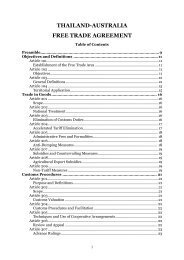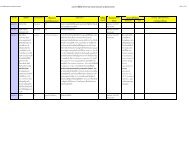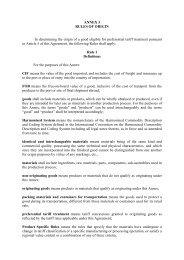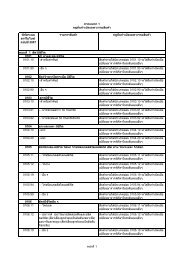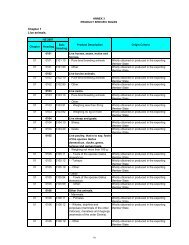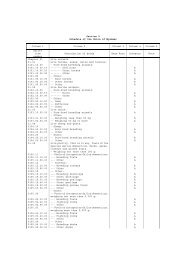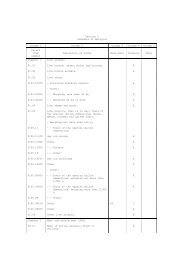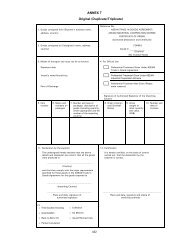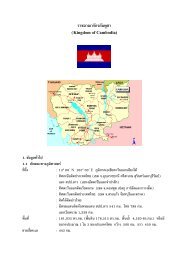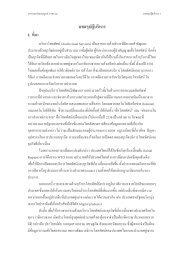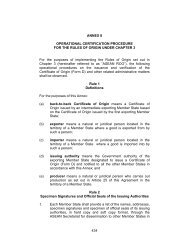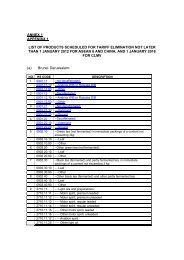International Standard Industrial Classification of All Economic ...
International Standard Industrial Classification of All Economic ...
International Standard Industrial Classification of All Economic ...
- No tags were found...
Create successful ePaper yourself
Turn your PDF publications into a flip-book with our unique Google optimized e-Paper software.
7<br />
Chapter II<br />
The underlying principles <strong>of</strong> the<br />
classification<br />
A. Purpose and nature <strong>of</strong> the classification<br />
1. General considerations<br />
22. In the study <strong>of</strong> economic phenomena, taking all elements into account<br />
simultaneously is not always possible. For the purposes <strong>of</strong> analysis, certain elements<br />
need to be chosen and grouped according to particular characteristics. Thus, all economic<br />
phenomena that are to be described in the form <strong>of</strong> statistics require systematic<br />
classification. <strong>Classification</strong>s are, so to speak, the system <strong>of</strong> languages used in communication<br />
about, and statistical processing <strong>of</strong>, the phenomena concerned. They divide<br />
the universe <strong>of</strong> statistical data into categories that are as homogeneous as possible with<br />
respect to those characteristics that are the objects <strong>of</strong> the statistics in question.<br />
23. ISIC is intended to be a standard classification <strong>of</strong> productive activities. Its<br />
main purpose is to provide a set <strong>of</strong> activity categories that can be utilized for the collection<br />
and presentation <strong>of</strong> statistics according to such activities. Therefore, ISIC aims<br />
to present this set <strong>of</strong> activity categories in such a way that entities can be classified<br />
according to the economic activity they carry out. Defining the categories <strong>of</strong> ISIC is as<br />
much as possible linked with the way the economic process is organized in units and<br />
the way in which this process is described in economic statistics.<br />
24. ISIC provides categories for the classification <strong>of</strong> units based on the activities<br />
carried out by these units, but it does not per se provide categories for specific<br />
types <strong>of</strong> units. This conceptual underpinning has been retained in the fourth revision<br />
for two reasons. First, naming actual units may be ambiguous if the same title or name<br />
is used differently across countries. For example, a “board <strong>of</strong> education” may have<br />
completely different functions and carry out completely different activities in different<br />
countries. Another example is the use <strong>of</strong> the term “Internet café”. In some cases, this<br />
term refers to a restaurant that provides (wired or wireless) Internet access to its customers<br />
as an amenity; in other cases it refers to a business service centre renting time<br />
on PCs along with Internet access and related activities; while in still other cases, it<br />
refers to a unit providing entertainment services by <strong>of</strong>fering games that can be played<br />
over the Internet. Such terminology may change from country to country or region<br />
to region. Therefore, creating categories for “board <strong>of</strong> education” or “Internet café”<br />
might lead to the classification <strong>of</strong> units in the same class that should not be compared.<br />
Second, the name or title <strong>of</strong> a unit may not reflect the activity carried out by the unit.<br />
For example, a shipyard is usually engaged in the building <strong>of</strong> ships. However, the same<br />
infrastructure can be used for the dismantling <strong>of</strong> ships. If such a shipyard carries out<br />
mostly the dismantling <strong>of</strong> ships, it should not be combined in the same class with<br />
other units that build ships. Therefore, classifying a unit based on its characteristic as<br />
being a “shipyard” (e.g., based on existing capital equipment) would be ambiguous.



